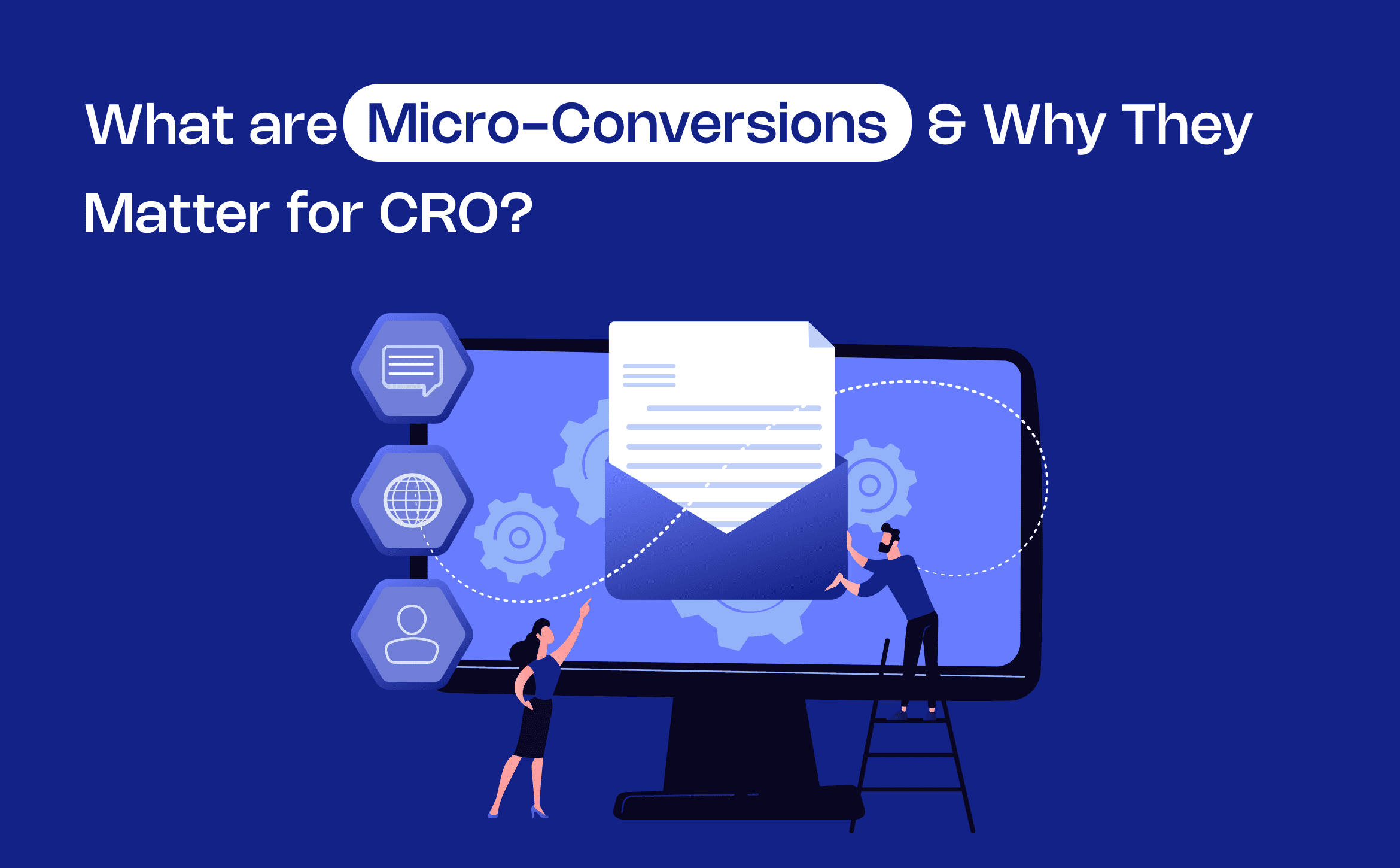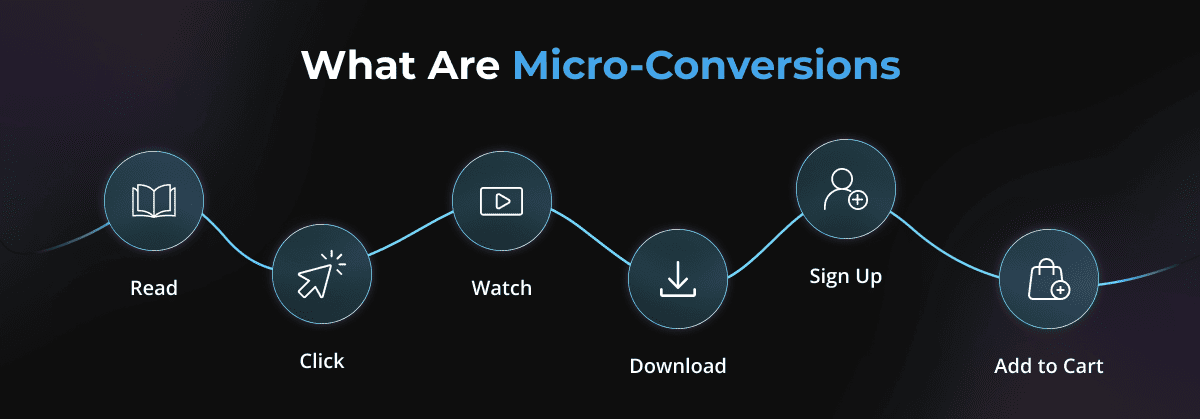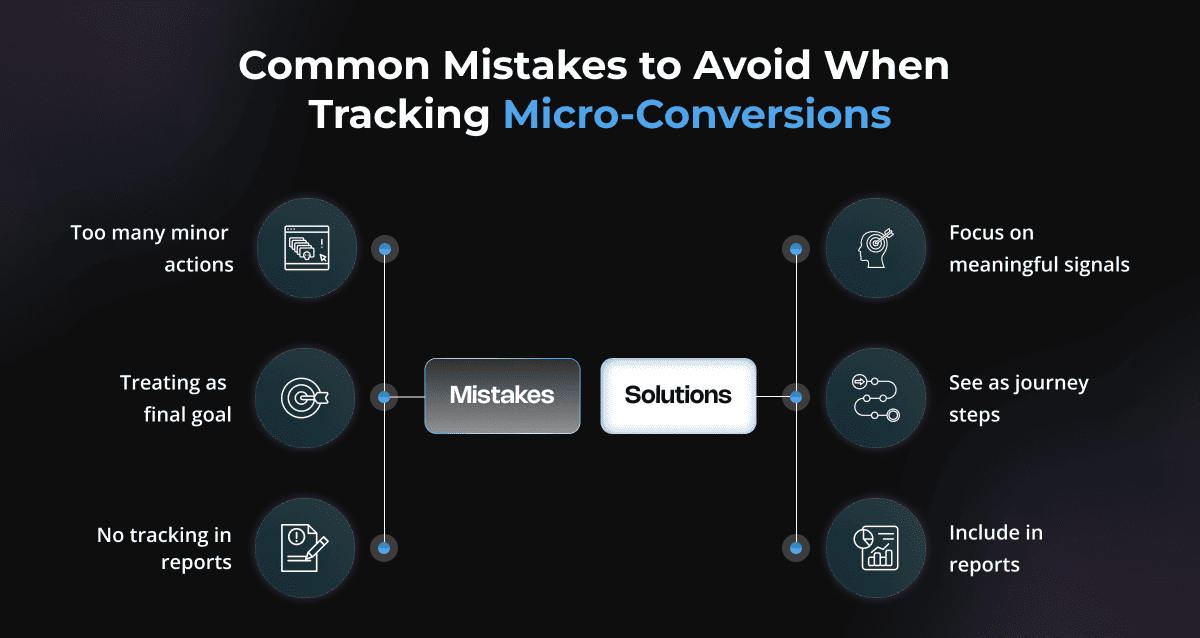What Are Micro-Conversions & Why They Matter for CRO?

Have you ever noticed your website getting plenty of visitors, but sales just don’t happen? It’s like someone walking into your store, looking around, maybe asking a couple of questions, and then walking out without buying. And it feels like a lost sale. But in reality, those small actions show genuine interest. They could very well come back to make a purchase.
Online works the same way. Someone reads your blog, watches a short video, downloads a guide, or signs up for your emails. Sure, it’s not a sale yet. But it’s a step closer.
In CRO (Conversion Rate Optimization), these are called micro-conversions, the little things people do that quietly say, “I’m starting to trust you.” They might not look big, but this is often where the real growth starts.
And this guide will show you why those moments matter, and how tracking them can turn casual visitors into loyal customers.
What Are Micro-Conversions?

Micro-conversions are the small steps people take before making the big move. It’s like silently saying “yes” without actually saying it. It could be clicking to learn more, signing up for your emails, adding something to the cart, or watching your video all the way through.
They don’t bring in a sale right away, but they show that interest is growing. Each one is a sign someone’s leaning in, testing the waters, and getting closer to trusting you enough to take that final step.
In CRO terms, the “big win”, the macro-conversion, might be a purchase or a booking. But without these smaller steps along the way, that big win may never happen.
Tracking micro-conversions is simply noticing the small actions that show someone is paying attention. When someone’s engaged, curious, or ready for more, that’s when you really start to understand your audience.
Why Micro-Conversions Matter for CRO

Now that you know what micro-conversions are, it’s easier to see how they quietly set up the bigger wins. Each small action builds momentum, moving someone closer to buying. If you’re not tracking them, you’re missing where things can get better.
Think of it like this: Someone’s looking for a handcrafted leather bag. They search online, see a bunch of options, and click on a few sites. When they land on yours, they browse your products, read the details, maybe check reviews, and then leave. They might come back later, or they might compare you with other brands. Those little actions aren’t just clicks; they’re signs someone’s interested, even if they don’t buy yet.
Every step like this shows you where people connect and where they hesitate. Noticing these moments helps you make their path smoother.
Action Tip: Try mapping these touchpoints on a simple journey chart. Mark where visitors drop off, then test small fixes like a clearer CTA, a reminder email, or shorter checkout steps. Even one change can reduce friction.
Small actions often lead to the biggest shifts, and that’s where the real opportunity starts.
What are the Common Types of Micro-Conversions
Micro-conversions help you see when someone is interested in your product or service. Not big commitments at first, but steps towards a purchase. And if you closely analyse these steps, you can understand the visitor’s journey, even if they are not ready to take the final step.
Here are common types of micro-conversions that show where your visitors are in their journey:
- Signing Up for a Newsletter
When someone signs up for a newsletter by sharing their email, they are at the entrance and want to know more about your products. They want to keep hearing from you, which can be the beginning of trust.
Quick Win: Offer a simple incentive, like a discount code, free guide, or exclusive tips, to make signups more likely.
- Adding Items to a Cart or Wishlist
When your visitors are not only exploring your online store but also adding items to a cart or wishlist, it means they found something that caught their attention. They might not be ready to buy yet, but they cared enough to hold onto it.
Quick Win: Use gentle cart reminders or wishlist notifications so the item stays top-of-mind without pressuring the buyer.
- Watching a Video or Downloading a Guide
When you see people spending their time watching your videos, reading content, or downloading a guide, this shows their curiosity. It means they are on stage, to learn and explore what you are offering. They are starting to feel a connection that you are offering something they are searching for.
Quick Win: End your videos or guides with a soft CTA, like “Ready to explore more? Click here.” This keeps the momentum flowing.
- Creating an Account or Logging In
When your visitors have started to log in or create an account, this step brings them closer to a purchase, as this is something personal and shows their trust. They are saying that they want more from you, and you are willing to take the next step.
Quick Win: Keep account creation simple, offer social logins or minimal fields so users don’t abandon midway.
Each of these small steps is like quietly saying, “Yes, I think this is what I am looking for,” and if you ignore these small actions, thinking that they are not the big wins, then you are missing out on the base of your selling journey. These actions show that they have slowly started to trust you.
So, you must pay attention to these steps in order to understand where they are coming from and how you are making it easier for them to take the next step.
How to Track Micro-Conversions Effectively

Now that you are aware of how these small micro-conversions are important for users to take a final step in their purchase journey. You might be wondering how you could actually track these micro-conversions, so that you could understand how users move through your site.
To make this easier, here are the right ways to track them and make the next step for your visitor easier:
1. Tools That Make Tracking Easier
The tools below will help you make the tracking easier and keep you well-informed about how your visitors are interacting with the website:
- Google Analytics 4: This tool gives you detailed insights into user behavior and lets you set up specific events for micro-conversions.
- Hotjar: Hotjar is great for heatmaps, recordings, and seeing exactly how people interact with your pages.
- HubSpot: HubSpot is best when it comes to connecting marketing actions, building relationships, especially if you’re tracking form fills or content engagement.
- Mixpanel: Mixpanel is a great tool to help you understand user journeys and see what actions lead to bigger conversions. It is best for SaaS or app-based platforms, while GA is more universal.
2. Metrics to Keep an Eye On
These metrics reveal what’s catching attention and how visitors are engaging with your content:
- Click-Through Rate (CTR): CTR shows how well your content or call-to-actions spark curiosity.
- Form Completion Rate: This reveals how easy and inviting your forms are.
- Video Watch Time: It tells you if your videos hold attention.
- Resource Downloads: This indicates a deeper interest in what you offer.
One of the most important things that you must keep in mind is that your tracking will only work well if it’s set up in the right way. If your events are not set up correctly, there’s a chance that you’ll miss important data. So, you must decide what you want to measure and make sure every action is tracked.
When you follow these steps consistently, you’ll start to see patterns. And these patterns show who’s ready, who’s curious, and who might just need a little more time. And from there, you can guide them forward with care, not pressure.
How Micro-Conversions Can Boost CRO Performance

Micro-conversions aren’t just numbers on a screen. They’re small signs that someone is leaning in, and each action quietly tells you, “I’m interested, keep going.”
The first step is to notice them. Map these moments to your customer’s journey, from the first curious click to the final decision. You’ll start to see where people naturally move forward and where they begin to turn away.
When you find those drop-off points, pause and look closer. Maybe there’s a form people give up on halfway through. Or a video they leave after a few seconds. These moments are clues, showing you where things feel heavy or unclear.
Then, make small, thoughtful changes. A shorter form. A friendlier design. Words that feel more inviting. Test one thing at a time and watch what shifts.
Here’s the quick Fix: If you notice a form drop-off, try removing one non-essential field and see if completion rates improve.
You can also try this: Add a progress bar to long forms; visitors are more likely to finish when they know how close they are.
In the end, every newsletter signup, video view, or download is a step forward. When you notice these steps and care for them, the bigger wins don’t feel forced; they happen naturally.
How Micro-Conversions Boosted Sales for an eCommerce Store

A tiny action can change everything. For this brand, it was newsletter signups, the quiet signal that turned browsers into buyers. By focusing on that single micro-conversion, we helped an eCommerce store lift sales by 15%.
The Challenge: High Newsletter Signups but Low Sales Conversions
A fast-growing eCommerce brand came to us looking for help with a micro-conversion boost. On the surface, things looked great. The site was engaging, products were loved, and newsletter signups were coming in at an impressive 40%.
But sales told a different story. People were interested, yet not buying. Somewhere between signing up and checking out, they were losing them.
Our Approach: Optimizing the Email Journey to Nurture Leads
We started by looking closely at the signup journey. The interest was there, but the follow-up emails weren’t building on it. The momentum people felt at the signup stage was slipping away. So, we reworked the email flow completely. Instead of generic templates, we sent messages that felt personal and relevant, helpful tips, product stories, and gentle nudges that fit naturally into their day. We tested subject lines, refined timing, and made each step lead seamlessly back to the store.
The Results: Turning Interest into a 15% Sales Increase
Within weeks, engagement grew. Trust followed, and so did sales. By focusing on one small but important signal, newsletter signups, and giving it the right attention, the brand increased sales by 15%.
It is a reminder that growth isn’t always about big moves. Sometimes, it’s about noticing the quiet moments and guiding people forward, one step at a time.
And if you’re looking for ways to turn small signals into real growth, we at tecHindustan can help you find and nurture them.
Common Mistakes to Avoid When Tracking Micro-Conversions

Even with the best intentions, it’s easy to get lost in the wrong details. Here are a few things that can help you avoid mistakes when tracking micro-conversion:
- When you track too many little actions that don’t really say much. Because not every click or scroll tells you something worth knowing. Pay attention to the ones that show real interest, the kind that help you see where someone’s heart or mind is leaning.
- Treating micro-conversions like the finish line is one of the most common mistakes. But they are not the end of the journey. They’re gentle steps along the way. Little moments that help guide someone closer to the bigger change you’re hoping for.
- Another mistake to avoid while tracking micro-conversions is letting them disappear from your reports. If you only measure the big wins, you’ll miss the quiet patterns and the signs that tell you how someone is moving in the right direction.
Keep your tracking simple, intentional, and connected to the bigger picture. This will help micro-conversions to become the small but powerful markers that show you the way forward.
Why Micro-Conversions Are Essential for CRO Success
When we talk about how micro-conversions are essential for CRO success, we must understand that they are not just small wins. They are the hints that something is catching attention. They are the nudges that something could be smoother.
When someone signs up, downloads a guide, or lingers a little longer on a page, they’re leaving you a clue. A small trace of their interest. A glimpse into what they might want next.
And if you are not paying enough attention to these moments, you may risk missing what truly shapes the bigger picture. The little things that make the whole thing work.
Paying attention to them means you see more than numbers. You see the story they’re telling, where people engage, where they pause, where they lean in without saying a word.
And these behavioural signals give you something you can act on. You don’t have to guess or make a huge leap. Sometimes, one careful change in the right place is all it takes for growth to follow naturally.
So, make sure to keep your eyes on these small moments because they’re often the ones who move everything forward.
Key Takeaways on How Micro-Conversions Drive CRO Success
Take a moment and think about the little things your visitors do. Clicking on a product, signing up for your newsletter, and pausing to read about a feature.
On the surface, they seem small. But often, they’re the first signs of something bigger, a spark of curiosity, a hint of trust beginning to grow.
Each micro-conversion is like a quiet nod from your audience. A way of saying, “I’m interested, keep going.” When you notice these moments and understand what they mean, you can shape experiences that feel natural. Gentle steps that guide someone forward, without forcing the pace.
Paying attention to them isn’t just tracking behavior. It’s understanding the story your visitors are telling you, and making it smoother for them to take the next step.
And if it ever feels like there’s too much to untangle, that’s okay. You don’t have to sort through it on your own. At tecHindustan, we’ll go through it with you, step by step, until those small signs start making big sense.